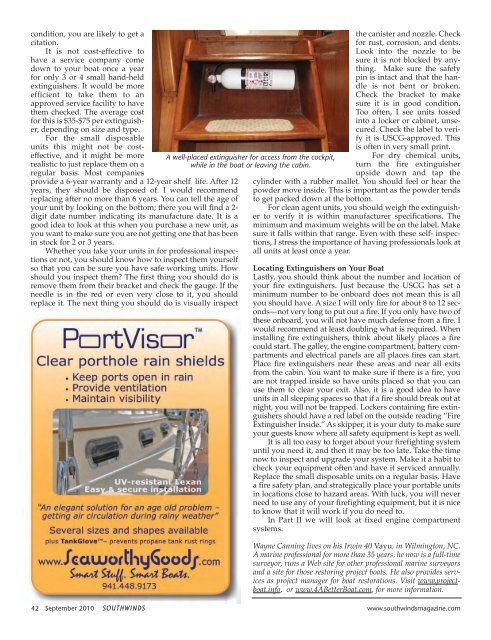Read PDF - Southwinds Magazine
Read PDF - Southwinds Magazine
Read PDF - Southwinds Magazine
Create successful ePaper yourself
Turn your PDF publications into a flip-book with our unique Google optimized e-Paper software.
condition, you are likely to get a<br />
citation.<br />
It is not cost-effective to<br />
have a service company come<br />
down to your boat once a year<br />
for only 3 or 4 small hand-held<br />
extinguishers. It would be more<br />
efficient to take them to an<br />
approved service facility to have<br />
them checked. The average cost<br />
for this is $35-$75 per extinguisher,<br />
depending on size and type.<br />
For the small disposable<br />
units this might not be costeffective,<br />
and it might be more<br />
realistic to just replace them on a<br />
regular basis. Most companies<br />
provide a 6-year warranty and a 12-year shelf life. After 12<br />
years, they should be disposed of. I would recommend<br />
replacing after no more than 6 years. You can tell the age of<br />
your unit by looking on the bottom; there you will find a 2-<br />
digit date number indicating its manufacture date. It is a<br />
good idea to look at this when you purchase a new unit, as<br />
you want to make sure you are not getting one that has been<br />
in stock for 2 or 3 years.<br />
Whether you take your units in for professional inspections<br />
or not, you should know how to inspect them yourself<br />
so that you can be sure you have safe working units. How<br />
should you inspect them The first thing you should do is<br />
remove them from their bracket and check the gauge. If the<br />
needle is in the red or even very close to it, you should<br />
replace it. The next thing you should do is visually inspect<br />
A well-placed extinguisher for access from the cockpit,<br />
while in the boat or leaving the cabin.<br />
the canister and nozzle. Check<br />
for rust, corrosion, and dents.<br />
Look into the nozzle to be<br />
sure it is not blocked by anything.<br />
Make sure the safety<br />
pin is intact and that the handle<br />
is not bent or broken.<br />
Check the bracket to make<br />
sure it is in good condition.<br />
Too often, I see units tossed<br />
into a locker or cabinet, unsecured.<br />
Check the label to verify<br />
it is USCG-approved. This<br />
is often in very small print.<br />
For dry chemical units,<br />
turn the fire extinguisher<br />
upside down and tap the<br />
cylinder with a rubber mallet. You should feel or hear the<br />
powder move inside. This is important as the powder tends<br />
to get packed down at the bottom.<br />
For clean agent units, you should weigh the extinguisher<br />
to verify it is within manufacturer specifications. The<br />
minimum and maximum weights will be on the label. Make<br />
sure it falls within that range. Even with these self- inspections,<br />
I stress the importance of having professionals look at<br />
all units at least once a year.<br />
Locating Extinguishers on Your Boat<br />
Lastly, you should think about the number and location of<br />
your fire extinguishers. Just because the USCG has set a<br />
minimum number to be onboard does not mean this is all<br />
you should have. A size I will only fire for about 8 to 12 seconds—not<br />
very long to put out a fire. If you only have two of<br />
these onboard, you will not have much defense from a fire. I<br />
would recommend at least doubling what is required. When<br />
installing fire extinguishers, think about likely places a fire<br />
could start. The galley, the engine compartment, battery compartments<br />
and electrical panels are all places fires can start.<br />
Place fire extinguishers near these areas and near all exits<br />
from the cabin. You want to make sure if there is a fire, you<br />
are not trapped inside so have units placed so that you can<br />
use them to clear your exit. Also, it is a good idea to have<br />
units in all sleeping spaces so that if a fire should break out at<br />
night, you will not be trapped. Lockers containing fire extinguishers<br />
should have a red label on the outside reading “Fire<br />
Extinguisher Inside.” As skipper, it is your duty to make sure<br />
your guests know where all safety equipment is kept as well.<br />
It is all too easy to forget about your firefighting system<br />
until you need it, and then it may be too late. Take the time<br />
now to inspect and upgrade your system. Make it a habit to<br />
check your equipment often and have it serviced annually.<br />
Replace the small disposable units on a regular basis. Have<br />
a fire safety plan, and strategically place your portable units<br />
in locations close to hazard areas. With luck, you will never<br />
need to use any of your firefighting equipment, but it is nice<br />
to know that it will work if you do need to.<br />
In Part II we will look at fixed engine compartment<br />
systems.<br />
Wayne Canning lives on his Irwin 40 Vayu, in Wilmington, NC.<br />
A marine professional for more than 35 years, he now is a full-time<br />
surveyor, runs a Web site for other professional marine surveyors<br />
and a site for those restoring project boats. He also provides services<br />
as project manager for boat restorations. Visit www.projectboat.info,<br />
or www.4ABetterBoat.com, for more information.<br />
42 September 2010 SOUTHWINDS www.southwindsmagazine.com

















